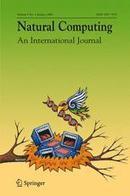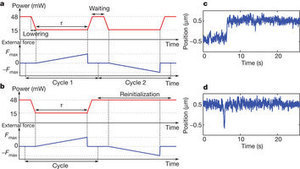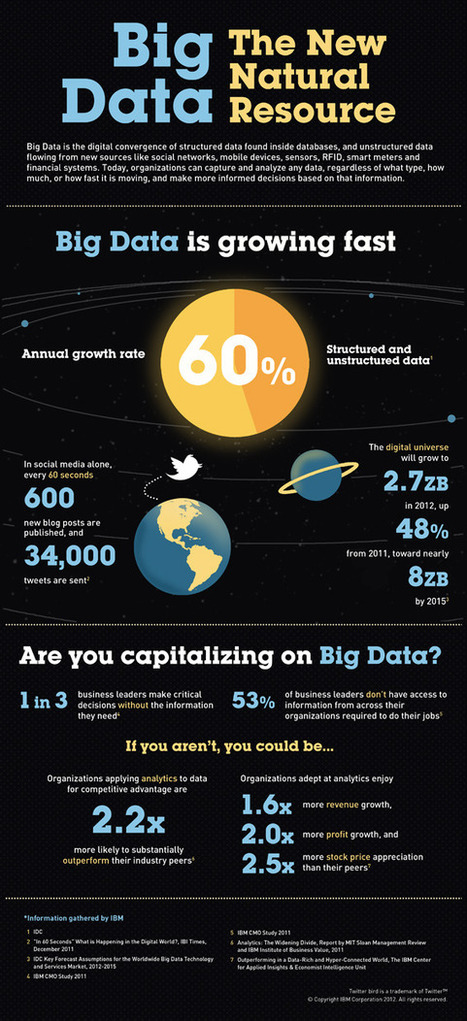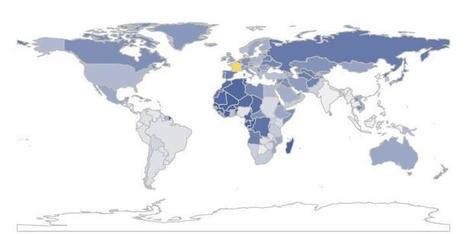 Your new post is loading...
 Your new post is loading...
During the last two decades, a systematic re-examination of the whole information science field has taken place around the FIS—Foundations of Information Science—initiative. With the occasion of its Fourth Conference in Beijing 2010, a group of selected contributors and leading practitioners of those fields have been invited to contribute to this Special Issue. What is the status of information science today? What is the relationship between information and the laws of nature? Is information merely “physical”? What is the difference between information and computation? Has the genomic revolution changed the contemporary views on information and life? And what about the nature of social information? Cogent answers to these questions and to quite many others are attempted in the contributions that follow.
We show novel techniques of analysing complex dynamics of cellular automata (CA) with chaotic behaviour. CA are well known computational substrates for studying emergent collective behaviour, complexity, randomness and interaction between order and disorder. A number of attempts have been made to classify CA functions on their spatio-temporal dynamics and to predict behavior of any given function. Examples include mechanical computation, lambda and Z-parameters, mean field theory, differential equations and number conserving features. We propose to classify CA based on their behaviour when they act in a historical mode, i.e. as CA with memory. We demonstrate that cell-state transition rules enriched with memory quickly transform a chaotic system converging to a complex global behaviour from almost any initial condition. Thus in just a few steps we can select chaotic rules without exhaustive computational experiments or recurring to additional parameters. We provide analysis of well-known chaotic functions in one-dimensional CA, and decompose dynamics of the automata using majority memory.

|
Suggested by
Joseph Lizier
|
Biological systems often consist of multiple interacting subsystems, the brain being a prominent example. To understand the functions of such systems it is important to analyze if and how the subsystems interact and to describe the effect of these interactions. In this work we investigate the extent to which the cause-and-effect framework is applicable to such interacting subsystems. We base our work on a standard notion of causal effects and define a new concept called natural causal effect. This new concept takes into account that when studying interactions in biological systems, one is often not interested in the effect of perturbations that alter the dynamics. The interest is instead in how the causal connections participate in the generation of the observed natural dynamics. We identify the constraints on the structure of the causal connections that determine the existence of natural causal effects. In particular, we show that the influence of the causal connections on the natural dynamics of the system often cannot be analyzed in terms of the causal effect of one subsystem on another. Only when the causing subsystem is autonomous with respect to the rest can this interpretation be made. We note that subsystems in the brain are often bidirectionally connected, which means that interactions rarely should be quantified in terms of cause-and-effect. We furthermore introduce a framework for how natural causal effects can be characterized when they exist. Our work also has important consequences for the interpretation of other approaches commonly applied to study causality in the brain. Specifically, we discuss how the notion of natural causal effects can be combined with Granger causality and Dynamic Causal Modeling (DCM). Our results are generic and the concept of natural causal effects is relevant in all areas where the effects of interactions between subsystems are of interest.
Does big data have the answers? Maybe some, but not all, says Mark Graham...
Public opinion is often affected by the presence of committed groups of individuals dedicated to competing points of view. Using a model of pairwise social influence, we study how the presence of such groups within social networks affects the outcome and the speed of evolution of the overall opinion on the network.
A universal map is derived for all deterministic 1D cellular automata (CA)
containing no freely adjustable parameters. The map can be extended to an
arbitrary number of dimensions and topologies and its invariances allow to
classify all CA rules into equivalence classes. Complexity in 1D systems is
then shown to emerge from the weak symmetry breaking of the addition modulo an
integer number p. The latter symmetry is possessed by certain rules that
produce Pascal simplices in their time evolution. These results elucidate
Wolfram's classification of CA dynamics.
Various research initiatives try to utilize the operational principles of organisms and brains to develop alternative, biologically inspired computing paradigms and artificial cognitive systems. This article reviews key features of the standard method applied to complexity in the cognitive and brain sciences, i.e. decompositional analysis or reverse engineering. The indisputable complexity of brain and mind raise the issue of whether they can be understood by applying the standard method. Actually, recent findings in the experimental and theoretical fields, question central assumptions and hypotheses made for reverse engineering. Using the modeling relation as analyzed by Robert Rosen, the scientific analysis method itself is made a subject of discussion. It is concluded that the fundamental assumption of cognitive science, i.e. complex cognitive systems can be analyzed, understood and duplicated by reverse engineering, must be abandoned. Implications for investigations of organisms and behavior as well as for engineering artificial cognitive systems are discussed.
Saint Matthew strikes again: An agent-based model of peer review and the scientific community structure
Flaminio Squazzoni, , Claudio Gandelli
In 1961, Rolf Landauer argued that the erasure of information is a dissipative process. A minimal quantity of heat, proportional to the thermal energy and called the Landauer bound, is necessarily produced when a classical bit of information is deleted. A direct consequence of this logically irreversible transformation is that the entropy of the environment increases by a finite amount. Despite its fundamental importance for information theory and computer science, the erasure principle has not been verified experimentally so far (…) This result demonstrates the intimate link between information theory and thermodynamics. It further highlights the ultimate physical limit of irreversible computation.
Many recent models of trade dynamics use the simple idea of wealth exchanges among economic agents in order to obtain a stable or equilibrium distribution of wealth among the agents. In particular, a plain analogy compares the wealth in a society with the energy in a physical system, and the trade between agents to the energy exchange between molecules during collisions. In physical systems, the energy exchange among molecules leads to a state of equipartition of the energy and to an equilibrium situation where the entropy is a maximum. On the other hand, in a large class of exchange models, the system converges to a very unequal condensed state, where one or a few agents concentrate all the wealth of the society while the wide majority of agents shares zero or almost zero fraction of the wealth. So, in those economic systems a minimum entropy state is attained. We propose here an analytical model where we investigate the effects of a particular class of economic exchanges that minimize the entropy. By solving the model we discuss the conditions that can drive the system to a state of minimum entropy, as well as the mechanisms to recover a kind of equipartition of wealth.
What do humpback whales returning to calve in the waters of Maui have to do with the ground state energy of a quantum system? Both exhibit a mathematical property called the "reduction phenomenon", which can be described very simply: mixing reduces growth, and differential growth selects for reduced mixing. The phenomenon underlies the Reduction Principle for the evolution of recombination, mutation, and dispersal rates, as well as recent results in reaction-diffusion models of dispersal. Animals returning to their birth places to give birth exemplify operation of the Reduction Principle through philopatry. In molecular genetics it is manifest as error-free DNA repair. In cultural evolution models it is manifest as traditionalism. Yet, departures from reduction are abundant, such as recombination and dispersal. How can sense be made of the complexity of outcomes? Two new papers describes mathematical results that extend the reduction phenomenon to infinite dimensional operators, and investigate departures from reduction which follow the "Principle of Partial Control". A new population statistic, the "fitness-abundance covariance", links ecological properties to the reduction phenomenon.
Recent developments in biotechnology have enabled interrogation of the cell at various levels, leading to many types of "omic" data that provide valuable information on multiple genetic and environmental factors and their interactions. The featured Web extra is a video interview with Mehmet Koyutürk of Case Western Reserve about how biotechnology can track genetic markers to advance cancer research.
An overview is given of theoretical progress on self-organization at the
nanoscale in reactive systems of heterogeneous catalysis observed by field
emission microscopy techniques and at the molecular scale in copolymerization
processes. The results are presented in the perspective of recent advances in
nonequilibrium thermodynamics and statistical mechanics, allowing us to
understand how nanosystems driven away from equilibrium can manifest
directionality and dynamical order.
|
We review the historic development of concept of information including the relationship of Shannon information and entropy and the criticism of Shannon information because of its lack of a connection to meaning. We review the work of Kauffman, Logan et al. that shows that Shannon information fails to describe biotic information. We introduce the notion of the relativity of information and show that the concept of information depends on the context of where and how it is being used. We examine the relationship of information to meaning and materiality within information theory, cybernetics and systems biology. We show there exists a link between information and organization in biotic systems and in the various aspects of human culture including language, technology, science, economics and governance.
Studies of ecological networks (the web of interactions between species in a community) demonstrate an intricate link between a community’s structure and its long-term viability. It remains unclear, however, how much a community’s persistence depends on the identities of the species present, or how much the role played by each species varies as a function of the community in which it is found. We measured species’ roles by studying how species are embedded within the overall network and the subsequent dynamic implications. Using data from 32 empirical food webs, we find that species’ roles and dynamic importance are inherent species attributes and can be extrapolated across communities on the basis of taxonomic classification alone. Our results illustrate the variability of roles across species and communities and the relative importance of distinct species groups when attempting to conserve ecological communities.
Reactions to textual content posted in an online social network show different dynamics depending on the linguistic style and readability of the submitted content. Do similar dynamics exist for responses to scientific articles? Our intuition, supported by previous research, suggests that the success of a scientific article depends on its content, rather than on its linguistic style. In this article, we examine a corpus of scientific abstracts and three forms of associated reactions: article downloads, citations, and bookmarks. Through a class-based psycholinguistic analysis and readability indices tests, we show that certain stylistic and readability features of abstracts clearly concur in determining the success and viral capability of a scientific article.
By Steve Mills
Senior Vice President and Group Executive
IBM
Frustration with “information overload” is one of the facts of life these days.
Via Spaceweaver
The very notion of social network implies that linked individuals interact repeatedly with each other. This notion allows them not only to learn successful strategies and adapt to them, but also to condition their own behavior on the behavior of others, in a strategic forward looking manner. Game theory of repeated games shows that these circumstances are conducive to the emergence of collaboration in simple games of two players. We investigate the extension of this concept to the case where players are engaged in a local contribution game and show that rationality and credibility of threats identify a class of Nash equilibria—that we call “collaborative equilibria”—that have a precise interpretation in terms of subgraphs of the social network. For large network games, the number of such equilibria is exponentially large in the number of players. When incentives to defect are small, equilibria are supported by local structures whereas when incentives exceed a threshold they acquire a nonlocal nature, which requires a “critical mass” of more than a given fraction of the players to collaborate. Therefore, when incentives are high, an individual deviation typically causes the collapse of collaboration across the whole system. At the same time, higher incentives to defect typically support equilibria with a higher density of collaborators. The resulting picture conforms with several results in sociology and in the experimental literature on game theory, such as the prevalence of collaboration in denser groups and in the structural hubs of sparse networks.

|
Suggested by
Hiroki Sayama
|
Social contagion: What do we really know? by Duncan Watts

|
Suggested by
Hiroki Sayama
|
Facebook Data Team wrote a note titled Mapping Global Friendship Ties. Read the full text here.
Science assessments indicate that human activities are moving several of Earth's sub-systems outside the range of natural variability typical for the previous 500,000 years. Human societies must now change course and steer away from critical tipping points in the Earth system that might lead to rapid and irreversible change. This requires fundamental reorientation and restructuring of national and international institutions toward more effective Earth system governance and planetary stewardship.
Social networks affect in such a fundamental way the dynamics of the population they support that the global, population-wide behavior that one observes often bears no relation to the individual processes it stems from. Up to now, linking the global networked dynamics to such individual mechanisms has remained elusive.
Identifying and removing spurious links in complex networks is meaningful for many real applications and is crucial for improving the reliability of network data, which, in turn, can lead to a better understanding of the highly interconnected nature of various social, biological, and communication systems. In this paper, we study the features of different simple spurious link elimination methods, revealing that they may lead to the distortion of networks’ structural and dynamical properties. Accordingly, we propose a hybrid method that combines similarity-based index and edge-betweenness centrality. We show that our method can effectively eliminate the spurious interactions while leaving the network connected and preserving the network's functionalities.
Complexity science unifies some forty diverse features that arise from the evolution of the civil system and these underlie theory development in the futures field. The main features of an evolutionary methodology deal with emergence, macrolaws, civil or societal transitions, macrosystem design, and the absorption of extreme events. The following principles apply: (1) The civil system is an open system in which investment capital is the system growth parameter that drives it away from equilibrium, with the formation of spatial structure. (2) The historical circumstances of human settlements provide a path dependency in respect of natural resources, defence, energy, transport, or communications. (3) Emergent properties arise within a complex adaptive system from which a theory of the system can be formulated, and these are not deducible from the features of the transacting entities. (4) Futures research identifies the conditions that will lead to an irreversible civil or societal phase transition to a new stage of development. (5) Emergent behaviour in the macrostructure at regional or continental levels can be influenced through critical intervention points in the global macrosystems.
The Turing Test (TT) checks for human intelligence, rather than any putative
general intelligence. It involves repeated interaction requiring learning in
the form of adaption to the human conversation partner. It is a macro-level
post-hoc test in contrast to the definition of a Turing Machine (TM), which is
a prior micro-level definition. This raises the question of whether learning is
just another computational process, i.e. can be implemented as a TM. Here we
argue that learning or adaption is fundamentally different from computation,
though it does involve processes that can be seen as computations. (…) We conclude three things, namely that: a
purely "designed" TM will never pass the TT; that there is no such thing as a
general intelligence since it necessary involves learning; and that
learning/adaption and computation should be clearly distinguished.
|
 Your new post is loading...
Your new post is loading...
 Your new post is loading...
Your new post is loading...

























